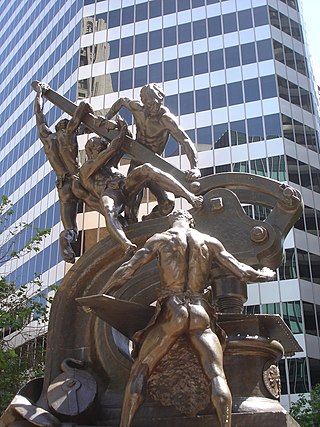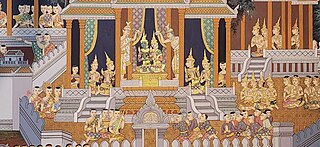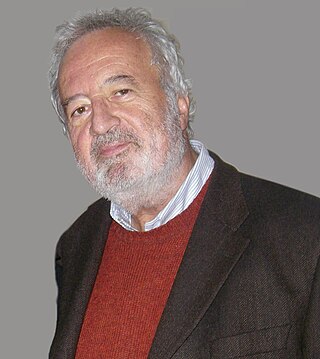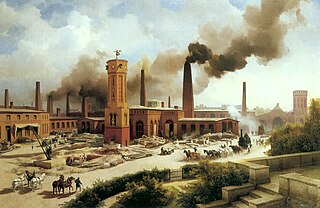Related Research Articles

A social class or social stratum is a grouping of people into a set of hierarchical social categories, the most common being the upper, middle and lower classes. Membership in a social class can for example be dependent on education, wealth, occupation, income, and belonging to a particular subculture or social network.
The bourgeoisie is a class of business owners and merchants which emerged in the Late Middle Ages, originally as a "middle class" between peasantry and aristocracy. They are traditionally contrasted with the proletariat by their wealth, political power, and education, as well as their access to and control of cultural, social and financial capital.

Social class in the United States refers to the idea of grouping Americans by some measure of social status, typically by economic status. However, it could also refer to social status and/or location. The idea that American society can be divided into social classes is disputed, and there are many competing class systems.

The middle class refers to a class of people in the middle of a social hierarchy, often defined by occupation, income, education, or social status. The term has historically been associated with modernity, capitalism and political debate. Common definitions for the middle class range from the middle fifth of individuals on a nation's income ladder, to everyone but the poorest and wealthiest 20%. Theories like "Paradox of Interest" use decile groups and wealth distribution data to determine the size and wealth share of the middle class.

Petite bourgeoisie is a term that refers to a social class composed of semi-autonomous peasants and small-scale merchants. They are named as such because their politico-economic ideological stance in times of stability is reflective of the proper haute bourgeoisie. In regular times, the petite bourgeoisie seek to identify themselves with the haute bourgeoisie, whose bourgeois morality, conduct and lifestyle they aspire and strive to imitate.
Producerism is an ideology which holds that those members of society engaged in the production of tangible wealth are of greater benefit to society than, for example, aristocrats who inherit their wealth and status.

The modern social structure of France is complex, but generally similar to that of other European countries. Traditional social classes still have some presence, with a large bourgeoisie and especially petite bourgeoisie, and an unusually large proportion, for modern Europe, of farming smallholders. All these groups, and the remaining industrial working class, have considerable political power, which they are able to flex when required.
Social class is an important theme for historians of the United States fordecades. The subject touches on many other elements of American history such as that of changing U.S. education, with Greater education attainment leading to expanding household incomes for many social groups. The overall level of prosperity grew greatly in the U.S. through the 20th century as well as the 21st century, anchored in changes such as growing American advances in science and technology with American inventions such as the phonograph, the portable electric vacuum cleaner, and so on. Yet much of the debate has focused lately on whether social mobility has fallen in recent decades as income inequality has risen, what scholars such as Katherine S. Newman have called the "American nightmare."
The African-American middle class consists of African-Americans who have middle-class status within the American class structure. It is a societal level within the African-American community that primarily began to develop in the early 1960s, when the ongoing Civil Rights Movement led to the outlawing of de jure racial segregation. The African American middle class exists throughout the United States, particularly in the Northeast and in the South, with the largest contiguous majority black middle-class neighborhoods being in the Washington, DC suburbs in Maryland. The African American middle class is also prevalent in the Atlanta, Charlotte, Houston, Dallas, New York, San Antonio and Chicago areas.

The social structure of China has an expensive history which begins from the feudal society of Imperial China to the contemporary era. There was a Chinese nobility, beginning with the Zhou dynasty. However, after the Song dynasty, the powerful government offices were not hereditary. Instead, they were selected through the imperial examination system, of written examinations based on Confucian thought, thereby undermining the power of the hereditary aristocracy.

The structure of social class in Cambodia has altered several times throughout its history. The traditional hereditary elites were marginalised in the 1970s, when military leaders gained prominence, before the Khmer Rouge attempted to dramatically eliminate existing class structures in the late 1970s. Since the emergence of peace in the early 1990s, social inequality has increased in Cambodia.
Marxian class theory asserts that an individual's position within a class hierarchy is determined by their role in the production process, and argues that political and ideological consciousness is determined by class position. A class is those who share common economic interests, are conscious of those interests, and engage in collective action which advances those interests. Within Marxian class theory, the structure of the production process forms the basis of class construction.
Belize's social structure is marked by enduring differences in the distribution of wealth, power, and prestige. Because of the small size of Belize's population and the intimate scale of social relations, the social distance between the rich and the poor, while significant, is nowhere as vast as in other Caribbean and Central American societies, such as Jamaica and El Salvador. Belize lacks the violent class and racial conflict that has figured so prominently in the social life of its Central American people.
Social classes in Iran have been divided up into upper class, propertied middle class, salaried middle class, working class, independent farmers, and rural wage earners. A more recent source divides Iranian classes into upper, middle class, working class, and lower class. Former Iranian President Mahmoud Ahmadinejad says 60 percent of his country's wealth is controlled by just 300 people in Iran. The gini coefficient was 0.38 in 2010 and the Human Development Index at 0.749 in 2013.

Fernando Vianello was an Italian economist and academic. Together with Michele Salvati, Sebastiano Brusco, Andrea Ginzburg and Salvatore Biasco, he founded the Faculty of Economics of the University of Modena and Reggio Emilia.

The working class, includes all employees who are compensated with wage or salary-based contracts. Working-class occupations include blue-collar jobs, and most pink-collar jobs. Members of the working class rely exclusively upon earnings from wage labour; thus, according to more inclusive definitions, the category can include almost all of the working population of industrialized economies, as well as those employed in the urban areas of non-industrialized economies or in the rural workforce.
The proletariat is the social class of wage-earners, those members of a society whose only possession of significant economic value is their labour power. A member of such a class is a proletarian or a proletaire. Marxist philosophy regards the proletariat under conditions of capitalism as an exploited class - forced to accept meager wages in return for operating the means of production, which belong to the class of business owners, the bourgeoisie.
The social structure of Spain in the 18th century continued to be based upon nobility and peasantry. However, the period also saw the growth of a middle class, centred upon the growing bureaucracy associated with Bourbon rule, and upon a limited development of commerce and industry.

Social class in Luxembourg after 1945 is generally based on occupation, personal income, and spending power as well as rights to social welfare rather than birth circumstances and family background. The country's demographic situation has changed considerably since 1945, where a mostly blue-collar working population gave way to mostly white-collar occupations over the second half of the twentieth century. Differences in consumer patterns between the white-collar and blue-collar workers decreased considerably between 1963 and 1977, causing a socio-economic evolution that saw a wider sphere of access for both working and middle classes to consumer goods such as cars, white goods, and real estate, thus demonstrating an equalisation of social strata in terms of income and spending power. The population of Luxembourg has also altered in nature due to significant growth in numbers of residents and increases in migration patterns since the mid-twentieth century; in 1961 13% of the population consisted of non-Luxembourgers, by 2020, this is at 44.3. At present, 47% of the Luxembourgish population has a migrant background’, and this is as a result of the response to socioeconomic processes that drew large numbers of immigrants to the country in the latter half of the twentieth century.

Industrialization in Germany was the phase of the breakthrough of industrialization in Germany, beginning at the time from around 1815 to 1835. This period was preceded by the periods of pre-industrialization and early industrialization. In general, the decades between the 1830s and 1873 are considered the phase of industrial take off. The Industrial Revolution was followed by the phase of high industrialization during the German Empire. The (catch-up) Industrial Revolution in Germany differed from that of the pioneering country of Great Britain in that the key industries became not the textile industry but coal production, steel production and railroad construction.